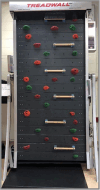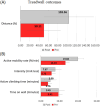Exploring the role of the rock climbing Treadwall as a novel therapy tool in physical rehabilitation
- PMID: 39749801
- PMCID: PMC11974484
- DOI: 10.1002/pmrj.13283
Exploring the role of the rock climbing Treadwall as a novel therapy tool in physical rehabilitation
Abstract
Background: Rock climbing offers numerous health benefits, but accessibility and safety concerns limit its therapeutic use, especially for individuals with disabilities. No prior studies have explored the potential benefits of integrating the Treadwall, a rotating climbing wall with improved accessibility and safety, into rehabilitation protocols.
Objective: To evaluate the safety and feasibility of implementing a Treadwall climbing intervention as a novel therapy tool for children with hemiplegic cerebral palsy. Additionally, we seek to explore potential functional benefits derived from the Treadwall intervention.
Design: This prospective, observational, single-site study assessed Treadwall training in a cohort of children with hemiparetic cerebral palsy while attending a 3-week intensive therapy program.
Setting: The study was conducted at the BECOME Program in Children's Specialized Hospital, Mountainside, NJ.
Participants: A total of 10 participants, aged 4 to 9 years, diagnosed with hemiparesis, were enrolled, with nine completing the intervention.
Interventions: The intervention involved 15 10-minute climbing sessions during the 3-week intensive therapy program. Participants' climbing distance, intensity, and active mobility rate were recorded.
Main outcome measure(s): Primary outcome measures included climbing distance, intensity, and active mobility rate. Secondary measures, the Assisting Hand Assessment (AHA) and Melbourne Assessment of Unilateral Upper Limb Function, were collected to assess upper limb function.
Results: The study demonstrated significant improvements in distance climbed (p < .01), intensity (p < .05), and active mobility rate (p < .05). Participants showed enhanced upper limb function, indicated by improved AHA and Melbourne Assessment scores (p < .01). Qualitative therapist reports showed positive feedback regarding the Treadwall's potential benefits.
Conclusions: The study supports the feasibility and safety of using the rock climbing Treadwall as a novel therapy tool for children with hemiplegic cerebral palsy. The intervention showed promising results in improving climbing skills, motor learning, and coordination. Future investigations should explore dosing and long-term outcomes to fully assess the Treadwall's therapeutic potential.
© 2025 The Author(s). PM&R published by Wiley Periodicals LLC on behalf of American Academy of Physical Medicine and Rehabilitation.
Figures



Similar articles
-
To be active through indoor-climbing: an exploratory feasibility study in a group of children with cerebral palsy and typically developing children.BMC Neurol. 2017 Jun 15;17(1):112. doi: 10.1186/s12883-017-0889-z. BMC Neurol. 2017. PMID: 28619011 Free PMC article.
-
Bimanual motor performance in everyday life activities of children with hemiplegic cerebral palsy.Eur J Phys Rehabil Med. 2021 Aug;57(4):568-576. doi: 10.23736/S1973-9087.21.06504-7. Epub 2021 Mar 18. Eur J Phys Rehabil Med. 2021. PMID: 33733719
-
A randomized controlled trial to compare two methods of constraint-induced movement therapy to improve functional ability in the affected upper limb in pre-school children with hemiplegic cerebral palsy: CATCH TRIAL.Clin Rehabil. 2018 Jul;32(7):909-918. doi: 10.1177/0269215518763512. Epub 2018 Mar 19. Clin Rehabil. 2018. PMID: 29552921 Clinical Trial.
-
Constraint-induced movement therapy in children with unilateral cerebral palsy.Cochrane Database Syst Rev. 2019 Apr 1;4(4):CD004149. doi: 10.1002/14651858.CD004149.pub3. Cochrane Database Syst Rev. 2019. PMID: 30932166 Free PMC article.
-
To constrain or not to constrain, and other stories of intensive upper extremity training for children with unilateral cerebral palsy.Dev Med Child Neurol. 2011 Sep;53 Suppl 4:56-61. doi: 10.1111/j.1469-8749.2011.04066.x. Dev Med Child Neurol. 2011. PMID: 21950396 Review.
References
-
- Aras D, Akalan C. The effect of anxiety about falling on selected physiological parameters with different rope protocols in sport rock climbing. J Sports Med Phys Fitness. 2014;54(1):1‐8. - PubMed
Publication types
MeSH terms
LinkOut - more resources
Full Text Sources
Medical

